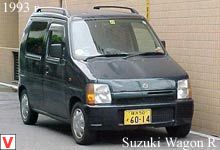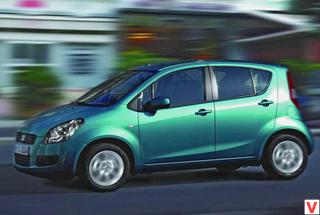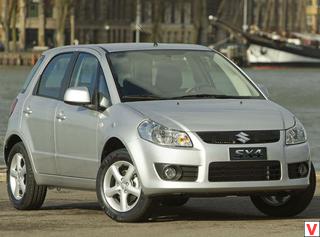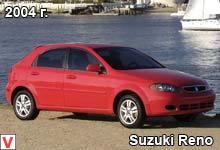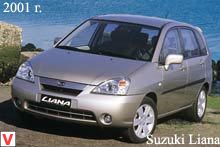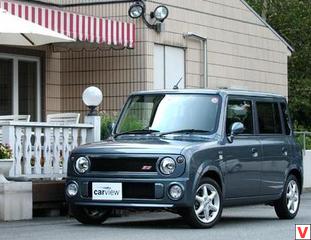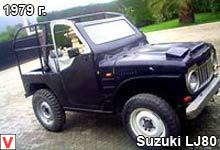
In 1968, Suzuki, which had previously produced only minicars, decided to go for a small engineering feat and launched an SUV under the name Jimny (LJ - light jeep Series). The car was distinguished by primitive body panels, the only flat windshield (leaning forward), external locks, springs on the hood and chains instead of doors. There were only three seats in the cabin. Due to the limitations of external dimensions, the spare wheel was placed behind the passenger seat. In this case, Jimny had a permanent four-wheel drive, independent spring suspension and a fairly solid frame.
The mass of the car was only 600 kg, and the length of the wheelbase was equal to 1930 mm. Under the hood there is a small two-cylinder 2-stroke engine with air cooling with a working volume of 0.36 liters and a power of 25 hp. In Japan, Jimny took the heat - more respectable local-made jeeps, not to mention imported ones, remained inaccessible to the vast majority of the population. But the delivery of the model to the foreign market was categorically excluded - the engine was no good, and Suzuki had nothing serious for a long time.

Finally, in 1974, the company mastered the 3-cylinder water cooling 2-tactic with a working volume of 0.55 liters and immediately installed this engine on a seriously updated Jimny SUV (LJ-Series), which also received a closed body with a spare wheel outside. allowed to place folding seats facing each other in the rear of the cabin. As a result, the functionality of Jimny seriously expanded - the car easily transformed into a small unpretentious van.
However, the Japanese were in no hurry to export. Risking to enter the automotive market in Australia, the company has not gained popularity there. Spring suspension and 2-stroke engine in the mid 70s were already considered an anachronism. Suzuki continued to improve its small SUV and in 1977 the new Jimny (LJ-Series) was released. Small changes were made to the body - the front wheel arches were enlarged and the rear arches were widened to give a more stylish design. The suspension has become softer. The hood held by two spring-loaded terminals, as in previous versions of LJ, was slightly raised to increase the space for the new engine.
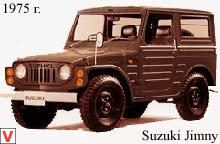
Its volume reached 0.8 l. The engine was four-stroke, four-cylinder, had water cooling and power of 41 hp. With this car, the company Suzuki entered the European market. His appearance marked the creation of a new sector of the all-wheel drive market. In 1982, he made his debut Jimny (SJ-Series) with a new graceful body.
The salon has become less ascetic and more comfortable for passengers. The suspension still used leaf springs, but they were softened by gas shock absorbers. The car was equipped with a four-cylinder four-stroke engine of 1.0 liter and 45 hp. Independent frame and small size combined with a more powerful engine made the Jimny (SJ-Series) a full-fledged SUV.

Thus, the market sector created by Suzuki continued to evolve. Then there was an improved version of the Jimny (SJ-Series), a distinctive feature of which was a lightweight four-cylinder engine of 1.3 liters and 60 hp. (injection) and 64 hp (carburetor). The gearbox has become a five-speed.
In 1986, the series went to a modified Jimny (SJ-Series), renamed for foreign markets in Samurai. Due to its extreme functionality, this unique model was successfully adopted in the world market and was sold in more than 100 countries around the world. In the USA, Samurai was recognized as the best all-wheel drive vehicle in terms of price-quality ratio. Since 1994, the Suzuki Samurai has an injection engine of 1.3 liters and a power of 69 hp. In Japan, in the period from 1990 to 1998, the Suzuki Jimny model was produced with a turbocharged engine of 0.66 liters and a power of 55 hp. From 1993 to 2002, the Jimny Sierra model was produced for the Japanese domestic market.

The peculiarity of this model is a carburetor four-cylinder engine with a volume of 1.3 liters and a power of 70 hp. The suspension used leaf springs. After 2002, the Jimny Sierra was equipped with a four-cylinder sixteen-valve water-injected engine with a capacity of 1.328 liters and 88 hp. In 1998, a presentation of the new Jimny was held. The “boxed” look, which looked a little rough, was a thing of the past.
Jimny lost sharp corners, body lines became smooth. Radical changes were subjected to the front of the car. In addition, Jimny received a spring suspension bridges, which significantly improved the ride and handling. There are two types of bodywork: a three-door all-metal and a convertible (either with a lowered soft top, or with a rigid removable plastic roof over the rear, the so-called hardtop). Despite more than compact dimensions (3625x1600x1705), the Jimny design is modeled on serious off-road vehicles: the body is mounted on a strong spar frame through rubber-metal cushions, on which the front and rear axles are mounted on springs and a system of levers.
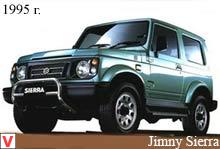
Plus part-time plug-in four-wheel drive with a dual ratio. The main advantage of this solution is a strong and relatively durable running gear, which allows to overcome serious obstacles, and the main restriction of patency in the case of the Jimny is the low ground clearance on the case of cross-axle differentials. Changes are not spared and salon. With an overall width of 1600 mm, there is no reason to talk about outstanding comfort or a large internal space - the cabin is designed for only four people. The design of the driver's seat in the Suzuki Jimny is based on advanced ergonomic research.
Counters and measuring devices are grouped so that at a glance to obtain the necessary information. Simple and practical. Armchairs, both front and back row are very comfortable and comfortable. The position of the driver's seat has become higher. The interior is solid, but austere. Central locking, power mirrors and power windows can be controlled by keys on a special panel. Air conditioning will take care of the microclimate in the cabin. The trunk is very small, but this is partly compensated for folding in parts (50:50) rear seats, as well as roof rails to install the upper trunk.
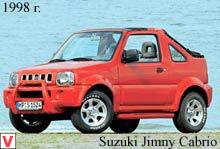
A powerful braking system includes a front brake with a large-diameter disc and an 8-inch vacuum booster that allows you to effectively brake with minimal effort. A load-sensing pressure limiter in the rear-wheel drive helps avoid their premature blockage during heavy braking and improves braking quality when the vehicle is heavily loaded. Suzuki Jimny is equipped with two front airbags. High head restraints in the front and rear seats protect passengers when they are hit from behind. And against side impact protection is also provided. These are steel protective beams of doors.
And one more important system - immobilizer. In Russia, Jimny is officially supplied with a single-shaft 16-valve 1.3 liter R4 (80 hp), a mechanical 5-speed or automatic 4-speed gearbox as an option. For some markets (in particular, for domestic Spanish), the Jimny is also produced with a more heavy-duty engine of 1.4 liters (1328 cm3), developing 82 hp. The relatively low torque of gasoline engines (104 and 110 N • m) compensates for the presence of a multiplier, so that on relatively flat areas with non-uniform coating (sand, mud, snow) Jimny owner will feel more confident compared to the owners of crossovers.
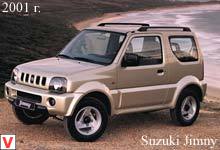
For the Japanese market, Jimny is mainly supplied with a 0.7 liter turbocharged engine (64 hp, 106 N • m). Under normal conditions, when driving on dry asphalt or a Jimny primer, it is strongly recommended to operate only with a connected rear axle, because when the front axle is turned on under these conditions, the transmission without a center differential and any viscous couplings wears out quickly, and the front axle that is turned off allows you to save fuel. However, with a 1.3-liter engine, even with the all-wheel drive Jimny “gluttony” not mentioned, you can’t name it - fuel consumption even on heavy off-road does not exceed 10 liters per 100 km.
In 2004, the diesel version appeared on the European market - Jimny 1,5 dCi. In the role of the main driving force is a four-cylinder engine with a capacity of 1.46 and 65 hp. The engine is made on advanced technology CommonRail with electronic fuel injection and consumes 6.1 liters per 100 kilometers. The maximum torque of 160 Nm, he gives out almost idle (2000 rpm) and can easily pull the trailer weighing 1.3 tons. Diesel Jimny is offered in the basic version of the Club and advanced Comfort.
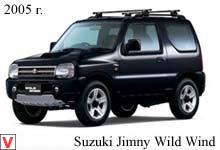
The starting modification is equipped with electric windows in the doors, ABS system, two airbags and a central lock. The Comfort version, plus everything, has air conditioning and heated rear-view mirrors. Jimny 2005 model year, in addition to the brilliant emblem, received from the creators of the new design of the five-spoke rims, new foglights, new color solutions for bumpers and the whole body. But the main differences begin in the cabin.
And continue to move. Salon of the world's smallest SUV meets new harsh, with distinct lateral support seats. The wheel is new, three-spoke, followed by a solid combination of devices that have received a silver edging. Under the hood of the updated Jimny engine capacity of 1336 cm ³ 80 hp The gearshift lever is now only one - the additional “handle” has organically transformed into convenient buttons on the center console. By the way, Jimny remains the only car on the market equipped with continuous bridges in front and behind. In December 2005, Suzuki launched the Jimny new Wild Wind bundle for sale. This version is more comfortable and the presence of various pleasant things.
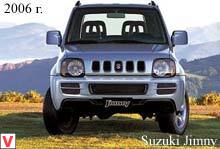
A new bumper and a body kit appeared, the front grille, now a little metallic, has changed, and, of course, it could not do without a stylish cover for the spare wheel located behind. The upholstery in the cabin has a special water-repellent coating, and the driver and passenger seats on the left are equipped with a heater, which, apparently, is very useful in winter. In addition, many additional pockets appeared near the rear row of seats. The steering wheel is sheathed in natural leather, and the air conditioner deflectors are framed “like metal”; a new stereo system with two speakers is installed in the cabin, playing CD / MD discs.
Of the color solutions of the Suzuki Jimny, there are five possible color options, including exclusive colors such as Gray (Graphite Gray Pearl Metallic), Black (Bluish Black Pearl) and Wine Red (Shining Red Pearl). In 2006, the company released the limited edition Suzuki Jimny Ranger. This version received a removable hitch with electrical wiring, grille separating the trunk, interior, trimmed with soft fabrics, rubber mats for the front passenger and driver, plus a flashlight with fastening. In addition, the limited edition is painted in dark green metallic, as well as the special color Ranger.
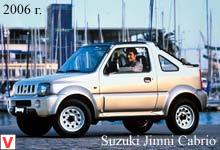
The engine range for this version is a 1.3-liter gasoline unit with an output of 86 hp and a 1.5-liter diesel.
